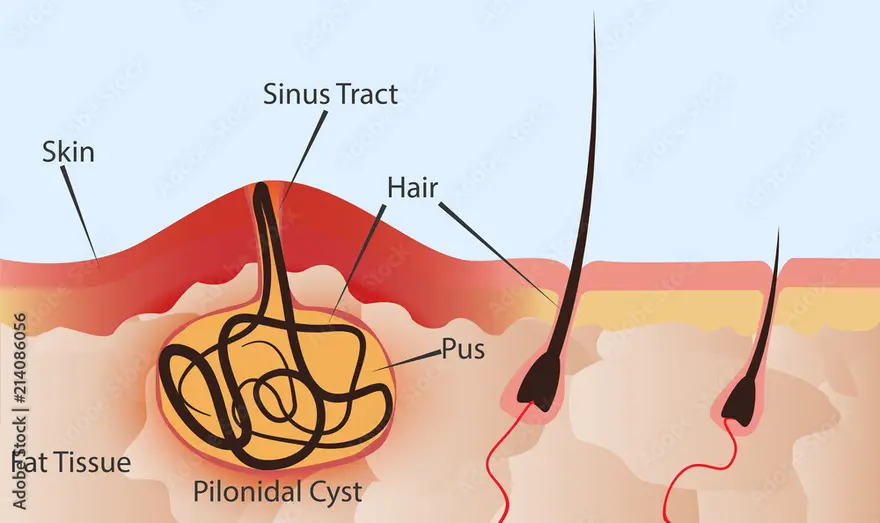Preventive Healthcare
Exploring Pilonidal Sinus: Symptoms, Causes, and Treatment

Table of Contents
- What is a Pilonidal Sinus?
- How Common is a Pilonidal Sinus?
- What are the Symptoms of a Pilonidal Sinus?
- What are the Causes of a Pilonidal Sinus?
- How are Pilonidal Sinuses Treated?
- What is the Outlook for Pilonidal Sinus?
- What Complications are Associated with a Pilonidal Sinus Infection?
- How Can I Prevent a Pilonidal Sinus?
- Conclusion
What is a Pilonidal Sinus?
A pilonidal sinus is a narrow passage that develops in the skin, typically located near the buttock cleft. Infections may occur, resulting in the formation of abscesses or cysts. This condition is frequently linked to ingrown hairs, causing pain, swelling, and discomfort.
How Common is a Pilonidal Sinus?
Pilonidal sinus is a relatively common condition; estimates suggest it affects about 26 out of every 100,000 people. It is most commonly found in young adults, especially males. While not everyone with a pilonidal sinus will experience symptoms, when complications arise, it can lead to pain, infection, and other discomforts.
What are the Symptoms of a Pilonidal Sinus?
If you have a pilonidal sinus infection, you might not experience pilonidal sinus symptoms initially. However, you may notice swelling and pain around the cyst when it becomes infected. A few pilonidal sinus symptoms include-;
- A pit near the top of your buttocks crease.
- Pain at the top of the cleft in your buttocks
- Swelling and inflammation of the skin in your buttocks.
- A pus-filled abscess can develop suddenly, causing pain and swelling and making it challenging to sit down.
- An unpleasant odour from draining pus.
What are the Causes of a Pilonidal Sinus?
The causes of infected pilonidal sinus remain unknown. Still, it is thought to result from a combination of factors such as hormonal changes (occurring after puberty), hair growth, and friction from clothing or prolonged periods of sitting.
Engaging in activities that create friction, like sitting, can compel the hair in the affected area to burrow beneath the skin. Your body perceives this hair as foreign, triggering an immune response, much like the reaction to a splinter. This immune response leads to the formation of a cyst around the hair. Sometimes, you may have multiple pilonidal sinuses that interconnect beneath the skin.
How are Pilonidal Sinuses Treated?
Pilonidal sinus is a condition characterised by the presence of a sinus tract in the sacral region. Pilonidal sinus diagnosis is typically established through clinical examination, which involves assessing symptoms, inspecting the affected area, and considering medical history. The pilonidal sinus treatments include conservative treatment, phenol injection, and surgery.
Conservative Treatment
- Opting for a non-surgical approach involves removing hair by shaving or with hair removal creams in the affected area and maintaining proper perineal hygiene.
- This method effectively manages pilonidal sinus infections in an outpatient setting, supporting a regular work routine.
- However, it is essential to note that the healing time associated with conservative treatment is typically longer compared to surgical techniques.
Phenol Injection
- Phenol injection presents an alternative pilonidal sinus treatment by injecting a solution into the sinus tract, aiming to destroy tissue and seal the tract.
- This procedure is generally conducted under local anaesthesia and effectively treats pilonidal sinus disease.
Surgery
- Surgical intervention becomes a consideration when conservative pilonidal sinus treatment proves ineffective or when the condition recurs.
- The choice of surgical procedure depends on the disease's severity. For instance, in uncomplicated, simple pilonidal sinus infection, excision and laying open or excision and primary closure (e.g., Karydakis procedure) can be performed.
- In more advanced cases:
- Excision and advancement flaps (e.g., V–Y flap) or excision and rotational flaps (e.g., Limberg flap) may be utilised.
- Innovative approaches like Endoscopic Pilonidal Sinus Treatment (EPSiT) involve exploration with an endoscopic camera, cauterisation, and cleaning of the sinus tracts.
- Despite surgical interventions, the risk of recurrence remains a concern, with some studies reporting a 50% recurrence rate.
What is the Outlook for Pilonidal Sinus?
The prognosis for individuals with a pilonidal sinus infection differs, and many can maintain a regular lifestyle with effective management.
In your daily routine, it is essential to stick to good hygiene practices, keeping the affected area clean and dry to prevent infections. If pilonidal sinus symptoms persist, your healthcare provider may prescribe medications or antibiotics.
To alleviate discomfort, consider making lifestyle adjustments, like avoiding prolonged sitting or maintaining a specific posture. Some pilonidal sinus treatments might be better than others. For example, surgical intervention may be considered for severe or recurring cases. While ongoing attention is needed, proactive management empowers you to lead a relatively normal life. Regular medical check-ups and adherence to your personalised healthcare plan can further play a crucial role in effectively coping with pilonidal sinus.
What Complications are Associated with a Pilonidal Sinus Infection?
In severe situations, a pilonidal sinus infection can give rise to complications. You might experience an infection that spreads or a secondary infection. Surgical procedures can also lead to potential issues, including:
- Suboptimal wound healing
- Numbness surrounding the wound
- Bleeding
- Pain
- Possible scarring
- Allergic reactions to surgical equipment, materials, or medications
- Infection at the surgical site
- Formation of blood clots
While rare, there could be a connection between pilonidal sinus and osteomyelitis (bone inflammation) or, in some instances, skin cancer.
How Can I Prevent a Pilonidal Sinus?
Preventing pilonidal sinus infection involves several proactive measures:
- Maintain cleanliness: To counteract skin infections leading to pilonidal cysts, keeping the buttocks and surrounding areas clean and dry is crucial.
- Recognise risk factors: Identify key risk factors to avoid pilonidal sinus. If you fall into categories such as being male, aged between puberty and 40, sitting for extended periods (common among office workers and truck drivers), overweight, having thick body hair, wearing tight clothing, or being pregnant, you may be more susceptible. Family history may also play a role.
- Manage weight: Being overweight is a common factor in pilonidal cyst development. Losing excess weight can contribute to preventing cyst formation.
- Stay active: Despite challenges, make an effort to move and alleviate pressure on your buttocks to discourage cyst formation.
- Consider hair removal: While the precise cause of pilonidal sinus is unclear, ingrown hairs in the buttocks' crease are believed to trigger infections. Regularly removing hair around the buttocks through methods like shaving can reduce the risk of ingrown hairs.
In case you develop a pilonidal cyst:
- Seek medical treatment: Prompt medical attention is essential to prevent complications such as abscesses, recurring cysts, and systemic pilonidal sinus infections.
- Look out for warning signs: If you experience worsening pain when sitting, notice a dimple or significant swelling between your buttocks, or observe abscess drainage with pus, blood, or foul-smelling fluid, along with symptoms like nausea, fever, and fatigue, seek immediate medical attention.
Conclusion
Understanding and taking proactive measures are crucial in dealing with pilonidal sinus infections. Maintaining hygiene, recognising risk factors, managing weight, staying active, and considering hair removal are effective preventive steps. Prompt medical attention is essential if pilonidal sinus symptoms arise, preventing complications and ensuring a better outcome. By incorporating these strategies into daily life, individuals can significantly reduce the likelihood of pilonidal sinus occurrence and enhance overall well-being. Embark on your path to pilonidal sinus treatment with tailored health insights. Metropolis Healthcare offers affordable and reliable thyroid function tests, empowering you to monitor progress. Book your test today for expert guidance on overcoming pilonidal sinus infection.

























